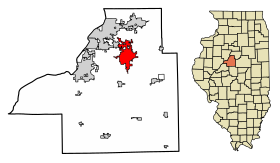Morton (Illinois)
| Morton | |
|---|---|
| Nickname : Pumpkin Capital of the World | |
|
County location (red) and Illinois county location
|
|
| Basic data | |
| State : | United States |
| State : | Illinois |
| County : | Tazewell County |
| Coordinates : | 40 ° 37 ′ N , 89 ° 28 ′ W |
| Time zone : | Central ( UTC − 6 / −5 ) |
| Residents : | 15.198 (as of: 2000) |
| Population density : | 450.7 inhabitants per km 2 |
| Area : | 33.83 km 2 (about 13 mi 2 ) of which 33.72 km 2 (about 13 mi 2 ) is land |
| Height : | 218 m |
| Postal code : | 61550 |
| Area code : | +1 309 |
| FIPS : | 17-50621 |
| GNIS ID : | 413862 |
| Website : | www.morton-il.gov |
| Mayor : | Norman Durflinger (President) |
Morton is a village in Tazewell County in the US state of Illinois . At the time of the 2010 United States Census , Morton had a population of 16,267. There is a Libby’s bottling plant for canned pumpkins in Morton . Morton hosts the Morton Pumpkin Festival , which takes place annually in the second week of September .
It is said that 85 percent of the world's canned pumpkins are bottled in Morton, which is why Morton is also nicknamed Pumpkin Capital of the World .
geography
Based on the information on which the 2010 Census is based, Morton has a total area of 33.83 km 2 , of which 33.72 km 2 is land and 0.11 km 2 (or 0.34%) is water.
Morton is east of East Peoria on Interstate 74 , 14 km southeast of Peoria , 42 km northwest of Bloomington , 91 km north of Springfield , 182 km northeast of Quincy , 228 km northeast of St. Louis , 205 km southwest of Chicago and 138 km southeast of Davenport .
The place belongs to the Peoria Metropolitan Statistical Area .
history
The first white settlers in Morton, named after the former governor of Massachusetts , came from England, Ohio and New York between 1830 and 1835. A second wave of settlers arrived between 1860 and 1875. Most of them came from Switzerland and southern Germany.
Demographics
| Population development | |||
|---|---|---|---|
| Census | Residents | ± in% | |
| 1880 | 426 | - | |
| 1890 | 657 | 54.2% | |
| 1900 | 894 | 36.1% | |
| 1910 | 1004 | 12.3% | |
| 1920 | 1179 | 17.4% | |
| 1930 | 1501 | 27.3% | |
| 1940 | 2241 | 49.3% | |
| 1950 | 3693 | 64.8% | |
| 1960 | 5325 | 44.2% | |
| 1970 | 10,811 | 103% | |
| 1980 | 14,178 | 31.1% | |
| 1990 | 13,799 | -2.7% | |
| 2000 | 15.198 | 10.1% | |
| 2010 | 16,267 | 7% | |
| 2016 estimate | 16,287 | 0.1% | |
| US Decennial Census | |||
At the time of the United States Census 2010, Morton lived in 16,267 people. The population density was 481.8 people per km 2 . There were 6973 housing units, an average of 199.7 per km 2 . The Morton population was 96.3% White , 0.7% Black or African American , 0.2% Native American , 1.3% Asian , <0.1% Pacific Islander , 0.6% said belonging to other races and 1.0% named two or more races. 1.7% of the population declared to be Hispanic or Latinos of any race.
The residents of Morton distributed to 6622 households out of which 28.6% were living in children under 18 years. 58.4% of households were married, 7.0% had a female head of the household without a husband and 31.9% were not families. 27.6% of households were made up of individuals and someone lived in 12.4% of all households aged 65 years or older. The average household size was 2.41 and the average family size was 2.95.
The population was divided into 23.6% minors, 6.9% 18–24 year olds, 23.8% 25–44 year olds, 26.8% 45–64 year olds and 19.0% aged 65 years or more. The median age was 41.4 years. For every 100 women there were 92.8 men. For every 100 women over the age of 18, there were 90.0 men.
The median household income in Morton was 70,878 US dollars and the median family income reached the amount of 87,800 US dollars. The median income for men was $ 54,055, compared with $ 27,629 for women. The per capita income was $ 34,632. 4.9% of the population and 3.3% of families had an income below the poverty line , including 3.9% of minors and 5.4% of those aged 65 and over.
sons and daughters of the town
- Jay Ackerman , Farmer and MP at the Illinois House of Representatives
- David E. Lilienthal , director of the Tennessee Valley Authority and the Atomic Energy Commission
supporting documents
- ↑ a b Morton, Illinois ( English ) Village profiles. Retrieved May 23, 2018.
- ↑ G001 - Geographic Identifiers - 2010 Census Summary File 1 ( English ) United States Census Bureau . Retrieved May 23, 2018.
- ↑ Population and Housing Unit Estimates ( English ) Retrieved on 23 May 2018th
- ^ Census of Population and Housing ( English ) Census.gov. Retrieved June 4, 2015.
